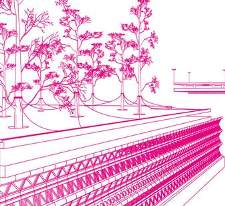A radical proposal to create the world’s first growing architecture, involving tree-like buildings that absorb CO2, has won the BSRIA and Designing Buildings Wiki tomorrow’s challenges in today’s buildings competition
The competition was launched on 4 October and asked: how can buildings be designed today to ensure they are resilient to the changes they will face tomorrow? Entrants were asked to “dust off all those wild innovations you thought of in the middle of the night and write down the bizarre solutions you usually only reveal in the pub!”
Entrants offered a wide range of solutions including: bomb-proof construction; using rooftops for food production, using ocean waste to make building materials, electrifying the entire construction industry and many, many, more…
More than half of the entries related to the challenges of energy, efficiency, climate change and climate resilience. Other recurring topics covered: demographics and changing lifestyles, resource scarcity and specific threats such as earthquakes and terrorism.
The winning concept came from Bob Hendrikx, a Dutch architecture student, at the TU Delft.
His entry offers the creation of self-sufficient homes by means of the world’s first growing architecture, a modular system of construction based around living trees that absorbs CO2 rather than emitting it, and generates renewable energy.
Bob is the founder of The Motown Movement, an urban initiative to combat climate change by making sustainable technology accessible to everyone. He was also named one of the top 100 young sustainable entrepreneurs in the Netherlands.
Bob was awarded £500 worth of BSRIA membership, training or publications, and along with four runners-up, will be featured in BSRIA’s Delta T magazine and on Designing Buildings Wiki.
The runners-up included:
- Rami El Geneidy, a Master of Research student at the London-Loughborough Centre of Doctoral Training in Energy Demand
- He proposed the use of smart energy efficiency contracts in the domestic market, providing heating and energy as a service, rather than buying gas or electricity per unit. This places the onus for performance on the supplier, incentivising them to invest in energy efficient properties.
Rami said: “The thing that drives me is finding how to ensure sustainability of our energy use in the long-term. In my multi-disciplinary and rigorous empirical research I wish to achieve this by being mindful of the interplay of technology, economics and people.”
- Tomasz Sikorski, a UK-based project manager and recent MSc graduate in Building Services Engineering
- His solution addressed increasing transportation problems and the emergence of drone technology, suggesting that buildings should be designed to allow airborne delivery and re-charging of vehicles.
Tomasz said that he is interested in intelligent buildings, BIM, sustainability, public security and modern architecture. He is currently writing a book about intelligent systems in facilities management.
- Aurora Barrett, studying real estate and planning, at the University of Reading
- She proposed that buildings should have an energy self-sufficiency capability for emergency situations such as power cuts or electromagnetic pulses (EMPs). Aurora was inspired by documentaries focusing on people in the US making their own sustainable residential properties with EMPs in mind.
She said: “I don’t think it would be unfeasible for this to be manifested in commercial space as well, at the same time making buildings more eco-friendly by managing their own resources and controlling their energy output.”
- Richard Tanner, a UK-based engineer for BAE Systems, currently reading for an MSc in Systems Engineering Management at UCL
- He identified power management as his future challenge and suggested that the entire network should be integrated, responsive and designed to be easily upgradable as new technologies become available or affordable. This would include appliances, buildings, cars and infrastructure.
BSRIA’s Information & Knowledge Manager, Steve Sansom, said:
“BSRIA is pleased to have been involved in this competition and is delighted with the range, ingenuity and creativity of the entries submitted. Bob’s idea stood out as a genuinely realistic and stimulating way of using nature to generate renewable energy. BSRIA is always very keen to see more ideas fashioned that come under the low or zero carbon technology umbrella.
“It has been fascinating to see how innovative many of the competition entries were. Clearly, tomorrow’s challenges in today’s buildings is a subject close to the heart of many people.
BSRIA is supportive of first steps that building designers can take towards tackling future trends. This competition has led to cutting edge industry-changing processes.”














